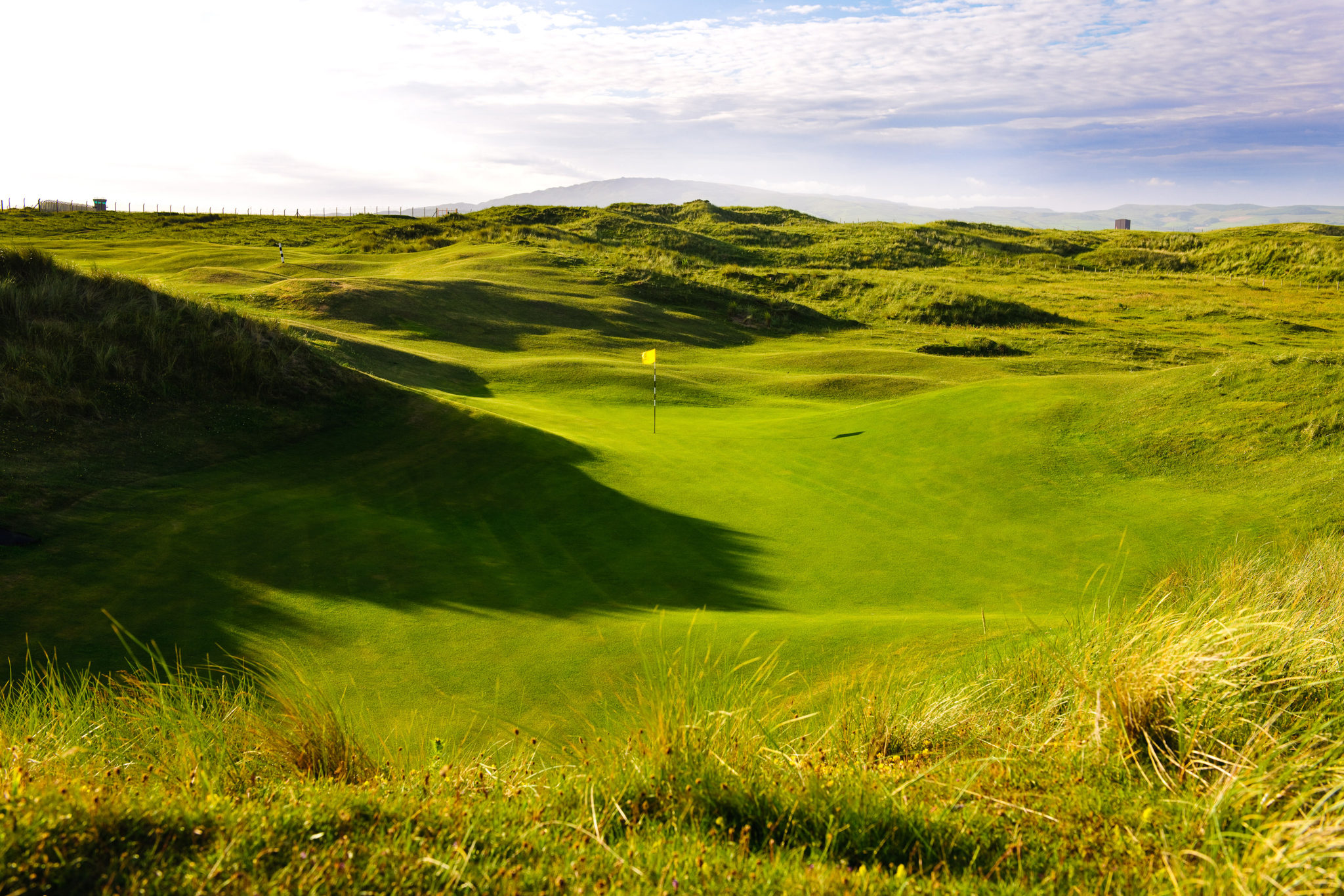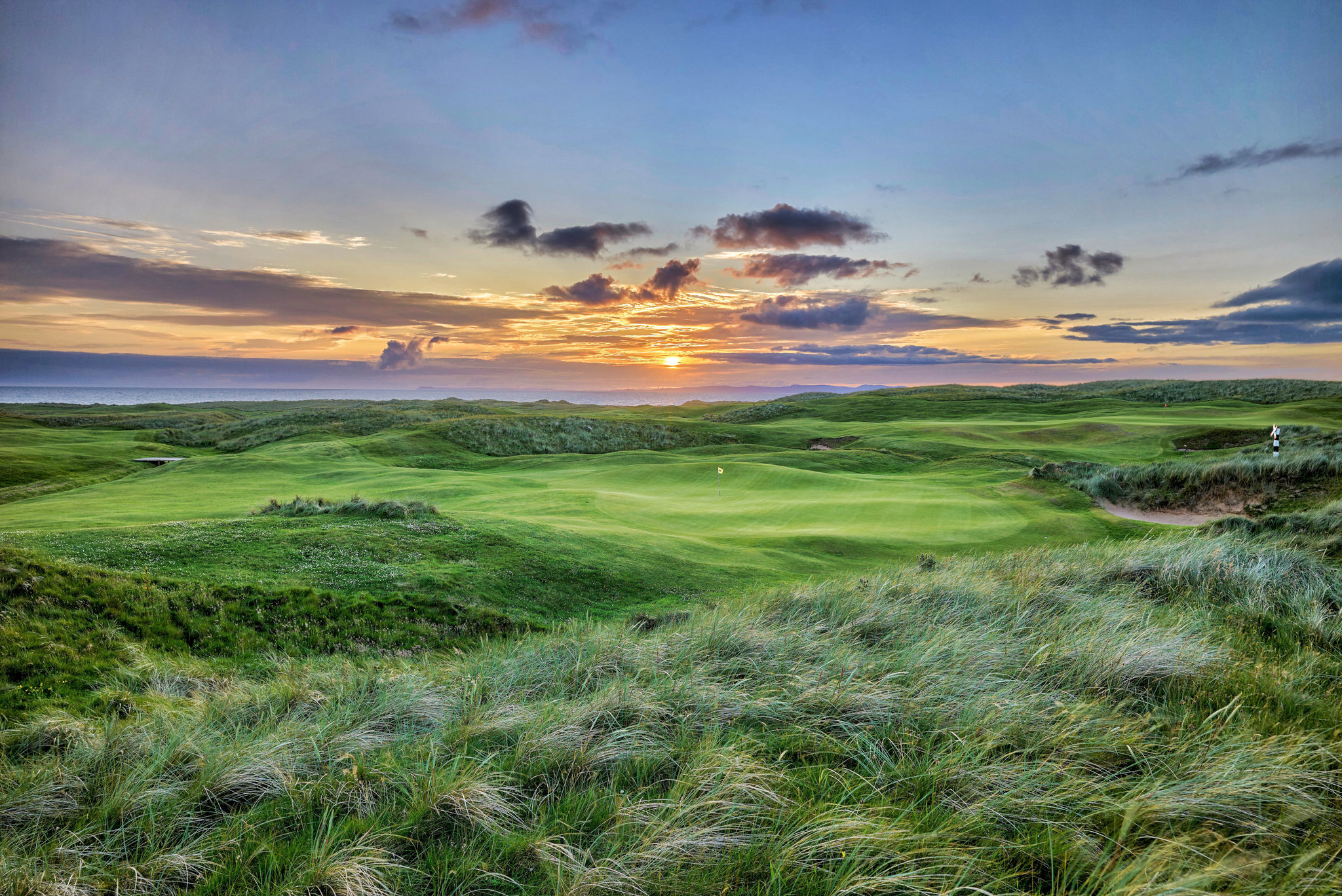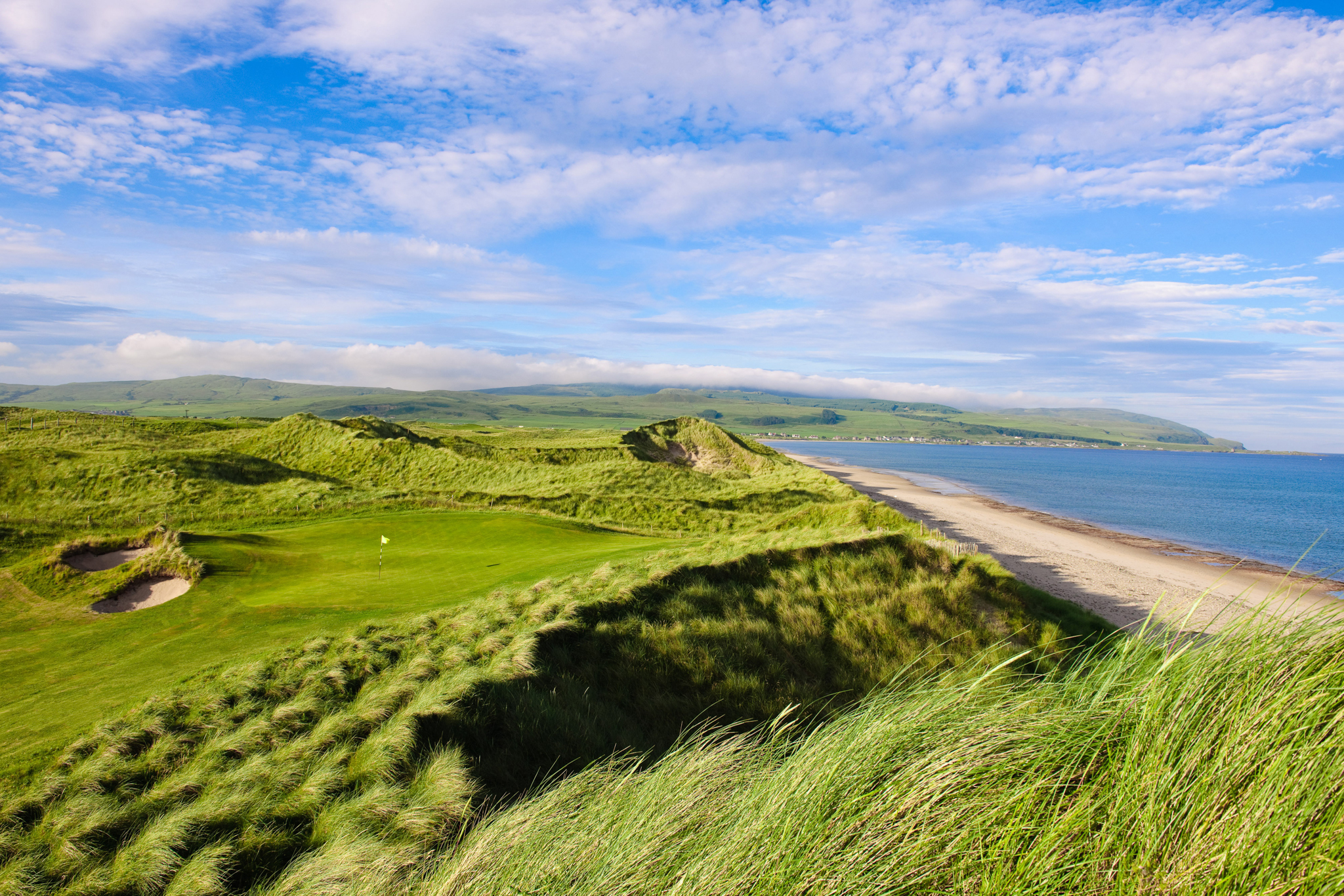Scotland, day two: Machrihanish Dunes, a wild golf adventure
A relatively new course conjures the golf of 130 years ago
MACHRIHANISH, ARGYLL, Scotland — If I have ever before used the phrase “wild and woolly” to describe a links golf course, please forgive that exaggeration. I wrote too soon; that is, before playing Machrihanish Dunes Golf Club, a place where the phrase is apt.
Here is adventure — fairways with mounds that can truly become mountainous; blind shots followed by more blind shots, on the same hole, with only the aiming posts as your guide for your tee shot, or to mark a hidden green; hikes through the dunes, from green to tee; ominous bunkers; challenging greens.
And here is true beauty, near the bottom of the Mull of Kintyre along the shore of Machrihanish Bay of the North Atlantic Ocean, the sound of the surf always in your ears, the waves rolling up on the beach often not far below the course itself.
Thing of it is, the golf course has become, by various accounts, much more playable than it was when it opened in May 2009, when a ball hit off the fairway was inevitably lost, but that’s getting ahead of the story.
Which begins with an Australian businessman Brian Keating, who made his fortune with Apple, Inc., sought a new challenge in the early 2000s and was inspired by a friend, noted Scottish golf photographer Brian Morgan, to build a golf course. Keating decided he wanted a links course, there being fewer than 300 in the world, and found this dunesland abutting historic, internationally famous Machrihanish Golf Club, laid out by Old Tom Morris in 1879.
Keating leased the land from a farmer and hired Scotsman David McLay Kidd, whose credentials already included Bandon Dunes and Tetherow in Oregon, to design the course, a course that Kidd had been waiting all his life to design, because he’d spent summers in these dunes as a youngster, and had played Machrihanish Golf Club countless times.
Along the way, Keating entered a partnership with David Southworth, whose company, Boston-based Southworth Development, would manage both the golf course and two hotels (and a pub) that Keating had also acquired, the run-down Ugadale Hotel in Machrihanish, just across the street from Machrihanish Golf Club, and the Royal Hotel in nearby Campbeltown.
Kevin Lewis, marketing director and interim general manager for the golf course and hotels, an erstwhile PGA professional from Tucson, came to Machrihanish to oversee the operation — what became a $30 million investment, he said — for Southworth in 2008.

Then, the golf course was under construction, to become the first new golf course in western Scotland in 100 years, and was limited severely by strict environmental regulations — designated a Site of Special Scientific Interest — that restricted earth-moving to tees and greens, and limited mowing beyond the narrow fairways, which were created simply by mowing the grass that was there, and following natural contours through the dunes. “The largest piece of equipment used was a backhoe,” Lewis said.
“With very few exceptions — there are a couple places where we’ve been allowed to drop the dune a little bit, and we’ve actually improved sight-lines on several holes, off the tee so that instead of a blind shot you’ve got a little notch you can see through — the land is what it is, and what it was. We tell everybody that we built this on eight or nine acres of ground (on a site covering about 270 acres); it was leveling tees and building the greens into the terrain as the terrain was.
“The fairways were as they are, and we simply started mowing them. The grasses weren’t desirable, but we couldn’t put new grasses in, and as we mowed it became shorter and more playable and over time it’s crowded out the bad grasses. The only thing we seeded were greens and tees. We’re not allowed to seed, or spray pesticides, herbicides or fertilizer, except minimally on greens.”
Initially, Kidd had the inspiration that rare Hebridean Black sheep would graze the course in the winter, controlling the rough as they would have during Old Tom’s time, and Machrihanish Dunes still has 200 black sheep that graze in the winter, but as Lewis notes, perhaps a flock of 1,000 might have been needed to truly maintain the course.
Which, when it was opened, was not universally beloved. The environmental restrictions forced some slogging hikes from greens to tees; golf balls hit off the fairways were lost; with the dramatically mounded fairways, it wasn’t an easy round at all.
“We had fairways 30 yards wide, and we couldn’t touch anything outside of that at all,” Lewis said. “The dunes grass gets three feet deep and that’s the way it was everywhere. When we opened, we got a lot of negative from that, because it was really hard to play. Now, a lot of people got that this was such a roll-back to links golf 100 years ago and they really liked it, but not everybody, and particularly Americans had a hard time with it, because they don’t totally understand links golf, at least not everybody.
“As time went on, the turf improved, the greens improved. As wild as it is today, it was wilder then. Things softened a little bit, we worked on the hikes between tees and greens, and tried to take some of the humps and bumps out of it without doing anything that would be opposed (by the environmental agency). ….”
“It used to be if you didn’t hit the fairway it was gone. Now it’s a very playable golf course.”
From his original design, Lewis said, Kidd has re-done two greens, moving the 17th green, which required a long carry over wetlands and a gaping bunker, to create a more accessible hole, and the No. 6 green, a par 3 close the sea, because of ongoing issues with salt spray, a problem affecting the No. 5 green now.
Over time, Lewis said, the golf course operation built some credibility, and some restrictions on the width of fairways and playing areas were loosened.
“One of our taglines here is ‘the way golf began,'” Lewis said. “It’s so true. If you and I could go back 130 years, and have a look at Machrihanish Golf Club when it was just laid out and open a couple of years, it wouldn’t have looked any different than our course.”
Meanwhile, in Southworth worked on remodeling the two hotels, which reopened in 2012, upgraded the pub near the Ugadale Hotel & Cottages and is now marketing cottages there, in what’s billed as The Village of Machrihanish Dunes (that happens to be just across the street from Machrihanish Golf Club) that can be rented by the night or purchases in shares. At the Ugadale, a great place, rooms are 169 British pounds (about $225) or 199 pounds (about $265) for rooms and 229 pounds (just over $300) for suites.
(Greens fees at Machrihanish Dunes are 95 British pounds for a day pass (about $125), or 75 pounds for a single round (about $99). Caddie fees are 45 pounds per bag (about $60), plus tip, which is expected. The course does about 10,000 rounds a year.)
At the invitation and intercession of David Connor of VisitScotland, I played Machrihanish Dunes on Saturday with three Northwest colleagues in golf journalism:
Former Register-Guard sports editor and columnist (and then of the Seattle Times) Blaine Newnham, one of the most respected golf writers in the Pacific Northwest, author of “America’s St. Andrews” about the construction of Chambers Bay and a friend and mentor to me throughout my career; Tom Cade, director of communications for the Pacific Northwest Golf Association and editor of Pacific Northwest Golfer Magazine, and Rob Perry, the immensely gifted photographer (and golfer) who specializes in golf courses.
Some observations:
- This was a fascinating round of golf, and challenging, both golf-wise and physically. We’re relatively fast players, but the round took more than 4.5 hours to play, a factor of the terrain, and the hikes between some holes (and the fact that we didn’t take a caddie, as Lewis would have recommended). This isn’t quite a walking-only course; Lewis said three carts are available, but must be driven by caddies for environmental reasons.
- Despite the numerous blind shots, I only lost one golf ball Saturday, on a legitimately bad shot that deserved to get lost. And I didn’t find any golf balls, either, reflecting the fact that we weren’t spending a lot of time in knee-deep rough, something that wouldn’t have been the case here seven years ago. Among the other three players in the group, just one lost ball.
- We played on an overcast day, with a few sprinkles and nothing worse; had the wind been howling and the rain pelting down, this would have been a slog.
The course plays 6,314 yards from the white tees, with a par of 72, and 5,849 from the yellow markers. On this day, Cade, who plays to a 1.4 handicap, was our medalist, with a 3-over 75; Perry, a 4.4 handicap also playing from the white tees, shot 80. From the yellows, I hit the ball well, putted horrendously and managed a 98 (49-49) as, in their daily match, the two former Register-Guard sports columnists battled to a draw.

